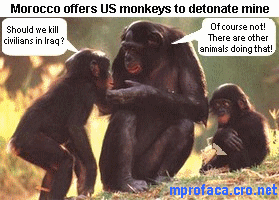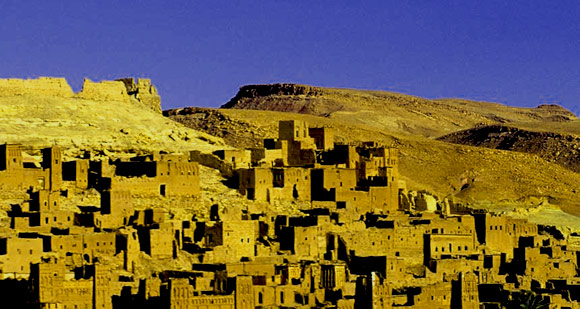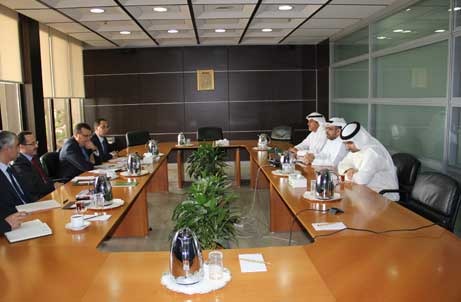Animals of Morocco







Dorcas Gazelle - is the smallest of all gazelles, but also has the longest legs. Both males and females have long, curved horns. They like to eat vegetation, especially Acacia leaves. They are active mostly during the early morning and eveing, since it is so hot in the middle of the day in the desert areas where they live. A Dorcas gazelle may go its entire life without drinking water, because it gets all that it needs from the plants it eats!
Fennec Fox - is the smallest of all foxes, but it also has big eyes and huge ears. The Fennec's ears help them keep cool in the desert heat and also help them hear potential food or enemies. Fennecs live in burrows where they sleep during the heat of the day. This is important since most Fennec foxes live near the Sahara desert. They hunt at night and like to eat insects, lizards, eggs and fruit.
Sloughi - (pronouce "Slew-gee") is a dog! It is also called an Arabian sighthound and is in the same family as greyhounds, afghans and salukis. This dog was originally bred in Morocco and was often bred for hunting. It has long legs and it runs very fast! Sloughis are faithful and intelligent and get along well with children.
Come on let’s see all the cool animals. There are birds. You can see all the different types of birds. You could see birds everywhere but not flamingos only in the Sous Messa National Park.
Did you know that there are camels! These camels live in the Sahara Desert. Mostly you can see them everywhere, even in markets. Camels have long necks. On the back of the camel it has a little bump. They cost $1,000 to by a camel. They use camels for races.
There are goats. These gaots are seen in most dry places like the dry mountains, and in some markets.
Animals of Morocco
moroccan elephants
Loxodonta africana Giant African elephants, whose tusks alone can weigh more than 45 kilograms (more than 99 pounds), are remarkable not only for their size but for their unique means of communication. Adults can talk to each other over vast distances using ultra-low-frequency sounds beyond the range of human hearing. These tones, which the elephants can hear over distances of hundreds of kilometres, may be analogous to the ocean songs of whales. Elephants once ranged through most of Africa south of the Sahara, but they are now seriously threatened by habitat destruction and ivory poachers. Between 1973 and 1980, Kenyas elephant population was reduced by 65 per cent, mainly because of rampant poaching. In 1989, in response to the growing threat of extinction, the Convention on International Trade in Endangered Species (CITES), the world body that regulates wildlife trade, banned the sale of ivory. The effect of the ban has not been determined, but biologists predict that African elephants will survive within protected areas throughout the continent.
Cape Hunting Dog
Lycaon pictus Enormous ears and conspicuous colours enable individual cape hunting dogs to locate each other quickly and to hunt as a pack, bringing down prey as big as twice their size. Like many other dogs, the cape hunting dog is very sociable; it roams the African grasslands and savannas in groups of as many as 60. Also known as the African wild dog, these animals were once quite common but are now seldom seen. The decline in their numbers results from predator-control efforts, habitat destruction, and a decrease in available prey.
Cheetah
Acinonyx jubatus The world s fastest land animal, the cheetah has been clocked at speeds of more than 105 kilometres per hour (more than 65 miles per hour) while running in pursuit of prey. Active during the day, these graceful animals are solitary hunters on the savannas and woodlands of Africa south of the Sahara. Despite their fierce appearance, cheetahs often lose small gazelle kills to more aggressive predators such as hyenas or lions. As a consequence of habitat loss and poaching for their prized skins, cheetahs are endangered throughout their range.
Chimpanzee
Pan troglodytes One of the closest animal relatives of human beings, the highly intelligent and gregarious chimpanzee lives in the tropical rain forests of equatorial Africa. Although these primates spend much of their time in trees where they forage for fruit, nuts, and leaves they are also active on the ground. Researchers have discovered that chimpanzees use a complex system of communication and maintain an elaborate, hierarchical social structure. Like other apes, chimpanzees are in peril because of the ongoing destruction of tropical rain forests.
Leopard
From southernmost Africa, the range of the leopard, Panthera pardus, sweeps in a great arc north through the rest of that continent and then across southern Asia as far as Java and the Russian Far East. It avoids only the driest reaches of the Sahara and the Eastern Desert. Throughout its vast and varied range, the adaptable leopard is remarkably tolerant of people, although people do not always return the favour. Its appetite for goats, sheep, and dogs angers farmers and pastoralists, and its spotted coat makes the leopard a target of hide-hunters. Black leopards also have a spotted coat, but the spots are difficult to discern against the coat s dark, glossy background.
Nile Crocodile
Crocodylus niloticus The Nile crocodile, which can weigh as much as 1 metric ton and can measure 6.5 metres (21.3 feet) in length, has killed more people on the African continent than any other animal. These mammoth reptiles feed mainly on fish and inhabit rivers, lakes, marshes, and coastal areas in Africa south of the Sahara and Madagascar. Shortly after World War II (1939-1945), the population of Nile crocodiles dropped sharply because they were being hunted for their valuable skins and because boat traffic had intruded near their nesting sites along the Nile. As a result of habitat degradation and excessive hunting, their numbers continue to decline today.
African Tree Pangolin
Manis tricuspis With overlapping brown scales on its back, this nocturnal West and Central African pangolin looks more like a slender pine cone than a mammal. When threatened, it will roll into a tight ball, exposing only a shield of scales. The pangolin lives high in the trees of the rain forest. Toothless, it uses its long snout and 18-centimetre (7.1-inch) tongue to probe for ants and termites.
Giraffe
Giraffa camelopardalis At 6 metres (19.7 feet) tall, the giraffe feeds on tree shoots and leaves that other animals on the African savanna cannot reach. A male will eat up to 91 kilograms (up to 201 pounds) per day. The giraffes long legs allow it to reach speeds of 58 kilometres per hour (36 miles per hour), but because its legs must be folded or awkwardly splayed to each side when it wants to drink, the gentle animal becomes easy prey for lions, hyenas, and leopards. Ever vigilant for predators, the giraffe succumbs to a true sleep for only 20 minutes each day. Each giraffes spotting pattern is unique, just like a human fingerprint.
Lion
Africa is so closely identified with the lion, Panthera leo, that many people are surprised to learn that a small population of lions endures in the Gir National Park of northwestern India. Lions once ranged throughout the Middle East, and even into Europe, where Macedonians and Greeks hunted them only 2,000 years ago. Even societies with no history of lions of their own, such as the United Kingdom and the Netherlands, have adopted the imposing cat as a symbol of national power. The very name of Singapore means Lion City, and the Chinese and Tibetans so revere the lion that they have bred several small dogsthe Pekingese, Lhasa apso, and shih-tzu in its image.
Spotted Hyena
Crocuta crocuta The hyena s long, muscular neck, furry round ears, and long front legs combine to look like a cross between a dog and a giraffe. However, the hyena belongs to the cat family, hunting at night and sleeping in the day in dug-out caves on the plains of eastern and southern Africa. Persistent and opportunistic, a pack of hyenas will spend hours wearing down their prey before closing in for the kill. The hyena is also adept at stealing other animals kill.
African Jacana
Actophilornis africanus This African water bird lives on the floating vegetation of ponds, lakes, and slow-moving streams, nesting on flimsy piles of weeds or lily pads. The male jacana must often hold the eggs under its wings when it roosts because its weight alone submerges the nest. Despite its aquatic home, the jacana rarely swims.
Greater Flamingo
Phoenicopterus ruber Thousands of these magnificent birds, which stand 1.2 metres (3.9 feet) tall on spindly legs, live together in the shallow brackish lakes and lagoons of southern Europe, Africa, Asia, and the Caribbean. In Africa, flocks can reach 1 million pairs. The flamingo feeds with its head upside down under water, filtering tiny plants and animals from the water. It constructs nests of heaped mud on the water, leaving the young vulnerable to changes in the waters level.
Hippopotamus
Hippopotamus amphibius This 3,600-kilogram (7,937-pound) mammal, a relative of the pig, is well adapted to aquatic life and spends its days lounging in rivers and lakes. Native to Africa south of the Sahara, a hippopotamus weighs 27 kilograms (60 pounds) at birth and can run and swim within five minutes. Its eyes, ears, and nostrils are set high on top of its head so they remain above water when the hippopotamus submerges. Its characteristic yawn is actually an aggressive gesture, and a competing male will slash another with its tusk-like teeth.
Hoopoe
Upupa epops Reaching 30 centimetres (11.8 inches) long, with a fan-shaped crest and black-and-white striped tail and wings, the hoopoe is easy to spot. This elaborately decorated bird from southern Europe, Asia, and southern Africa spends its days probing the soil for insects and grubs. Although timid, the hoopoe can elude most birds of prey. The birds nest is easy to identify by its foul-smelling accumulation of faecal matter.
Red-headed Weaver
In the savannas of Africa, the male of the red-headed weaver, Anaplectes rubriceps, uses palm-frond strips 60 centimetres (24 inches) in length to build an elaborate nest. He is a compulsive builder, often constructing several more nests than he actually needs. The rounded nest features a long, funnel-shaped entrance and hangs from a branch, offering excellent protection from enemies. Upon completing a nest, the male hangs upside down from the nests entrance and advertises himself to nearby females.
White-backed Vulture
Gyps africanus This vulture is not an early riser. It must wait for the sun to warm the ground, creating updrafts on which it can soar for hours. Its bald head and neck are adapted to sticking its head into carcasses. The white-backed vulture inhabits the open plains and savannas of southern Africa. There is a similar species of the white-backed vulture, Gyps bengalensis, found across southern Asia.
African Buffalo
An exception to the generally critical condition of the worlds wild cattle is the status of the African buffalo, Syncerus caffer. This imposing creature, frequently cited as the most dangerous of all large African animals, continues to range from semi-arid savannas to rain forests and from lowland swamps and reed-beds to high mountain meadows. The buffalo has retreated in many places as a result of hunting, settlements, agriculture, and a virulent disease called rinderpest, but the population still includes well over a million animals. Many people are familiar with the large, dark, heavy-horned buffalo of open country. The dwarf, reddish race from the dense equatorial forests is less well known.
Small-spotted Genet
Genetta genetta This swift and graceful catlike mammal is a skilled nighttime hunter. It prefers arid, bushy areas in Spain, southwest France, and Africa, avoiding rain forest and Sahara areas. Upon reaching a new home range, the genet memorizes every twig and branch. It walks its territory slowly at first, gradually increasing its speed until it can run through the area in the dark. Half of the genets 1-metre (3.3 foot) length is its tail.
Wild Cat
Felis sylvestris While this nocturnal hunter from the mountains of Europe looks like a large domestic cat, it is one of the fiercest of all cats and is untamable. Growing up to 75 centimetres (29.5 inches) long and weighing up to 7 kilograms (15.4 pounds), the wildcat is stouter and longer than a domestic cat. It hunts rabbits, grouse, and poultry, and it zealously defends its home territory.
Dromedary Camel
Camelus dromedarius Domesticated some 2,000 to 4,000 years ago for their ability to haul people and cargo, the camel is amazingly well adapted to life in the harsh deserts of Southwest Asia. Its two rows of eyelashes, slit nostrils, and hairy ear openings help keep out sand. While it cannot store water, it can drink more than 160 litres (more than 42 gallons) at a draught, and it can drink sea water. Its urine is highly concentrated, and its dung so dry it can be burned immediately. Camels drop their body temperature at night, which prolongs the heating-up period the next day. No wild camels remain in Asia, though an introduced population has gone feral in Australia.
Spiny-tailed Lizard
The fat, barbed tails of this lizard are a delicacy among the Bedouin people of North Africa. An inhabitant of the Sahara, the spiny-tailed lizard, Uromastix acanthinurus, differs from many desert dwellers in being active during the day, although it rarely moves. Adults are vegetarian, while the young will consume insects as they mature.
Warthog
Although considered outstandingly ugly by humans, a boar warthog, Phacochoerus africanus, looks just fine to the sow who loves him, warts and all. At mating time, those fibrous protuberances, which are much more prominent in the male, protect him from being injured by the tusks of other males when they engage in ritualized duels. In much of Africa south of the Sahara, the warthog shares its habitat of grasslands and open woodlands with the aardvark, whose burrows it frequently usurps. An adult warthog may back into one of these burrows to face a would-be predator with its formidable sharp tusks. When not deterred by this defence, lions or African wild dogs may enjoy a hearty warthog meal.
morocco culture,moroccan food,morocco food,moroccan cuisine,morocco beaches,moroccan meal,beaches in morocco,moroccan culture,hercules cave,hercules cave morocco

















